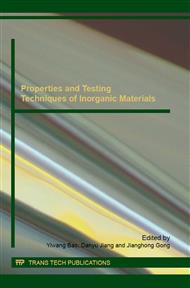p.472
p.477
p.482
p.486
p.493
p.498
p.502
p.507
p.511
Characterization and Vertical Elements Distribution of ZnGeP2 Single Crystals
Abstract:
A large, crack-free ZnGeP2 single crystal with size of Φ26 mm×70 mm was grown in a vertical three-zone tubular furnace by modified vertical Bridgman method, i.e. real-time temperature compensation technique with small temperature gradient in double-wall quartz ampoule. The as-grown single crystal was characterized by X-ray diffractometer (XRD), energy dispersive spectrometer (EDS), Fourier transform infrared spectroscopy (FTIR), and X-ray photoelectron spectroscopy (XPS). It was found that there is a face of (100) and its second-order XRD peaks were observed. The vertical elements distribution of the main part of the grown crystal has a stoichiometric ratio which is close to the ideal stoichiometry of 1:1:2. The IR transmittance of a sample of 2.5 mm thickness is above 58% in the range from 3500 to 800 cm-1. All these results demonstrate that the quality of the ZnGeP2 single crystal grown by the modified method is good, and could be used in the preparation of devices.
Info:
Periodical:
Pages:
493-497
Citation:
Online since:
February 2016
Authors:
Price:
Сopyright:
© 2016 Trans Tech Publications Ltd. All Rights Reserved
Share:
Citation:


